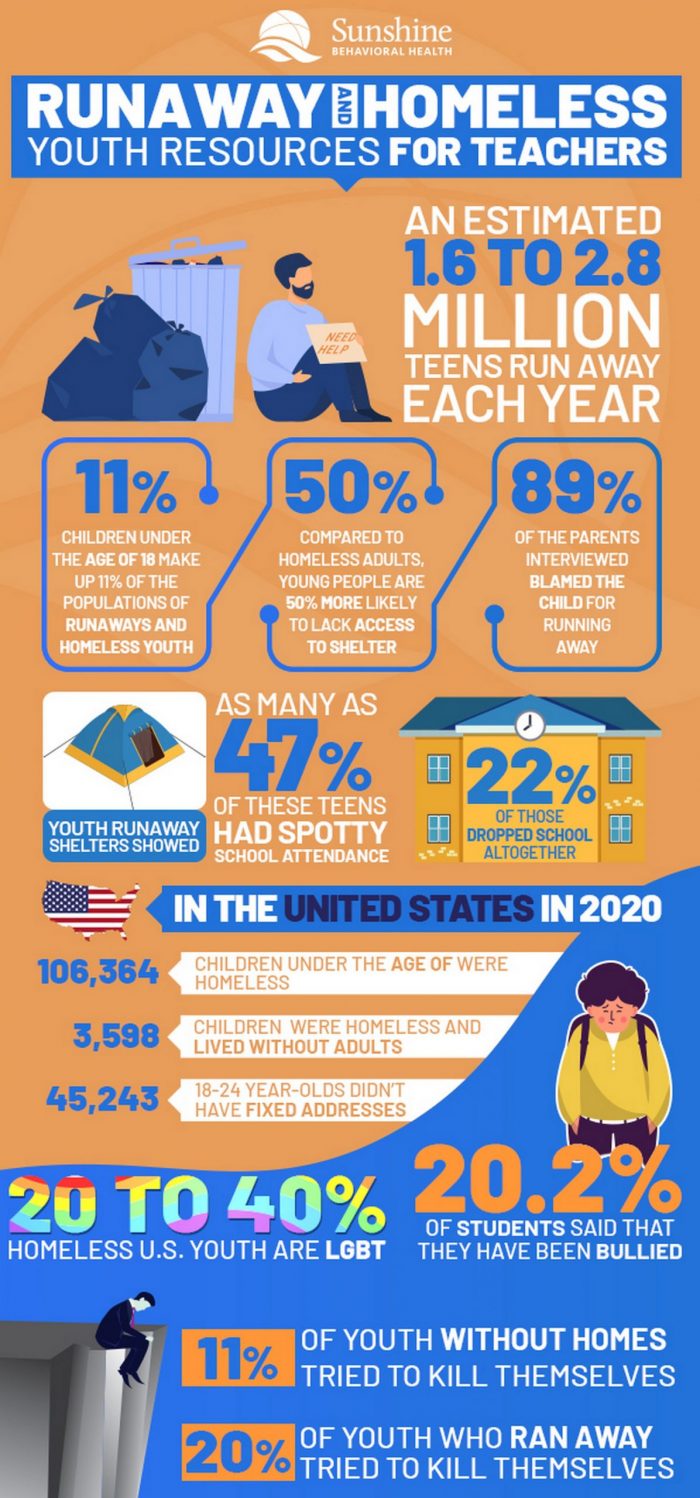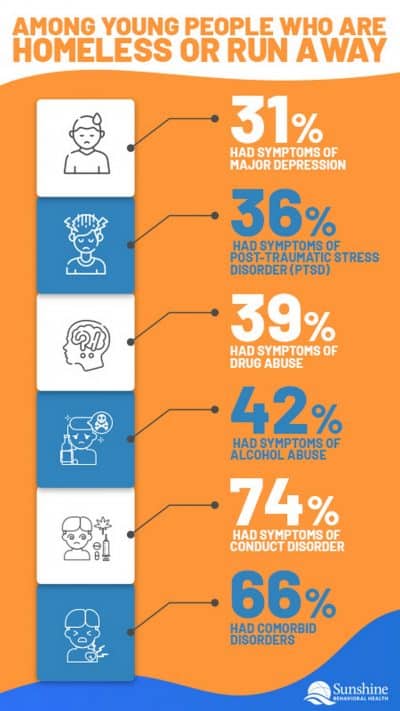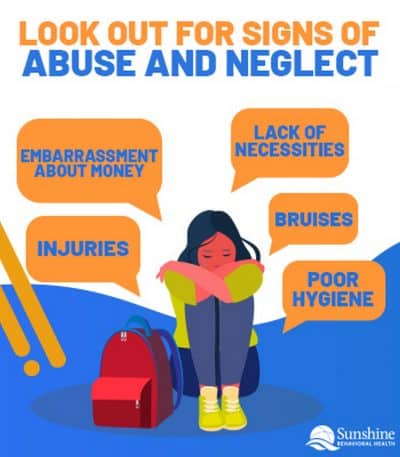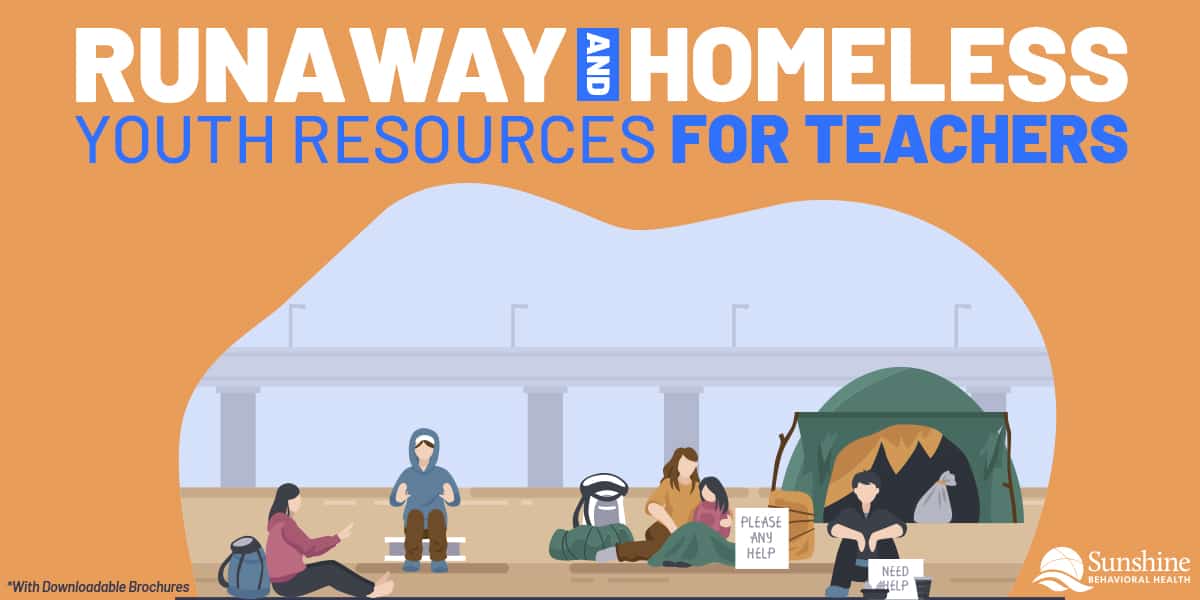Every year, from 1.6 million to 2.8 million U.S. children run away from home.
Meanwhile, in the United States in 2020, 3,598 children under the age of 18 were homeless and lived without adults, while 106,364 children in this age group were homeless. Among 18-year-olds to 24-year-olds, 45,243 people didn’t have fixed addresses.Many other children and young people are experiencing problems. They could be on the verge of homelessness or running away. Concerned, compassionate adults can help them.
Why do children run away?
It’s not easy being a child or young person, and it’s particularly difficult now. Some reasons they might run away include:
Bullying
The prevalence of social media makes it easy for young people to connect, but it also makes it easier for bullies to target victims online (cyberbullying).
Bullying is a problem for many children. The National Bullying Prevention Center reported that:
- About 20% (20.2%) of students said that they have been bullied.
- About 20% (20.9%) children nine to twelve years old have witnessed cyberbullying, cyberbullied others, or have been cyberbullied themselves.
- About half (49.8%) of nine-to-twelve-year-olds were the targets of bullying at school and 14.5% experienced online bullying.
As in other situations, the true extent of bullying might be unknown because people might not report bullying incidents or respond to polls or studies.
Abuse or neglect
Sometimes, children are mistreated by the very people responsible for caring for them. According to estimates, in the United States in 2019, neglect or abuse affected 656,000 children and killed an estimated 1,840.
More than 17,000 youth contacted the National Runaway Safeline in 2015. The safeline provides assistance and resources for young people who have run away from their homes or are considering doing so.
Of the young people who contacted the safeline, 16% asked for help because of neglect or due to emotional, verbal, sexual, or physical abuse.
Because of neglect or abuse, some children and young people enter foster homes or the child welfare system. Children in these situations sometimes run away or experience homelessness, or they might become homeless after they age out of the system (lose access to services once they’ve reached certain ages).
Substance use disorder or addiction
Substance use disorder and addiction are also linked to running away and youth homelessness.
One 2005 study of runaway and homeless young people found that
- 60.5% of the young people had a lifetime criteria for alcohol dependence, alcohol abuse, or drug abuse, or a combination of the disorders.
- 48.1% had a 12-month criteria for alcohol dependence, alcohol abuse, or drug abuse.
- 93% of the young people who had a substance use disorder had at least one other mental disorder.
Other times, youths run away from home because they’re fleeing environments where other people, such as their parents or guardians, are abusing drugs or alcohol or are addicted to the substances.
LGBT affiliation
An estimated 9.5% of U.S. young people 13 to 17 years old are members of the lesbian, gay, bisexual, and transgender (LGBT) community, according to 2020 data. Yet other statistics noted that this population accounts for 20 to 40% homeless youth.
Families and caretakers sometimes disown LGBT for their sexual orientations and identities and force them from their homes. Other LGBT youth experience bullying, abuse, neglect, substance use disorder, and other problems that can lead to homelessness.
Other issues
Still more young people run away because they’re pregnant or because they’re experiencing violence, financial problems, or instability at home. They might have strained or troubled relationships with their parents or guardians, or they might have emotional or mental conditions.
All these reasons could prompt young people to run away and eventually become homeless.

What can happen when children run away from home or become homeless?
Children who run away from home or become homeless for various reasons are often struggling. Running away or spending time homeless can make these problems worse, and they can cause new struggles. Some of these problems might include:
Mental health and substance use disorder issues
Some youth run away because of mental health problems. Others develop mental health problems because of their time on the streets.
Compared to young people with more stable housing, young people in unstable housing situations are more likely to attempt suicide, said a 2020 study. Researchers found that
- 11% of youth without homes tried to kill themselves in the previous year.
- 20% of youth who ran away in the prior year tried to kill themselves.
- 33% of youth who ran away and experienced homeless in the preceding year tried to take their own lives.
Another study found that among young people who are homeless or run away:
- 31% had symptoms of major depression.
- 36% had symptoms of post-traumatic stress disorder (PTSD).
- 39% had symptoms of drug abuse and 42% had symptoms of alcohol abuse.
- 74% had symptoms of conduct disorder, which is a behavioral and emotional disorder featuring antisocial behavior.
- 66% had comorbid disorders, which is the existence of more than one disorder at the same time.
Youth who run away or are homeless might need assistance to treat mental health disorders, but they might not know about this assistance or how to access it.
Assaults, exploitation, and crime
Running away and homelessness can be physically dangerous as well. Statistics indicated that 62% of LGBTQ youth who experienced homelessness were harmed physically and 47% of non-LGBTQ youth without homes also were also assaulted. Some might engage in criminal activities as a means of supporting themselves.
Exploitation is also common for youth in such situations. Lacking money to buy basic needs, some homeless young people exchange sex to pay for necessities: 27% of members of the LGBTQ community and up to 9% of members outside the LGBTQ community.
Poverty and health consequences
Poverty is common before, during, and after homelessness and running away. Sometimes, financial problems prompt adults to kick young people out of their homes or cause the whole family to become homeless or bounce among different housing situations.
Once homeless, young people often don’t have the income to pay for basic necessities or funds to improve their situations. They can’t afford transportation that could help them commute to jobs or tuition that could eventually help them find employment.
Food insecurity is also a problem for unaccompanied and homeless youth. Some might have access to little or no food. Some might have food, but it doesn’t meet nutritional standards.
Due to food-related risks, around 45 percent of youth and children experiencing homelessness are overweight or face high risks of becoming overweight. These young people might not receive the vital vitamins and minerals their still-growing bodies require and may suffer health consequences.
What are some signs children are homeless or may run away?
 To avoid such consequences, concerned adults might want to know some signs that could indicate if children are considering running away or if they’re already homeless.
To avoid such consequences, concerned adults might want to know some signs that could indicate if children are considering running away or if they’re already homeless.
If they’re at risk of running away, children and young people might:
- Talk about wanting to get away in general or get away from certain situations.
- Save money and gather their possessions.
- Earn lower grades, skip school, or get in trouble.
- Eat or sleep more or less than usual or display other atypical behavior.
- Harm themselves or engage in risky behavior.
- Show signs of abuse (bruises, injuries, nervousness when their home lives are mentioned) or neglect (poor hygiene, lack of necessities, embarrassment about money).
Similarly, if they’re homeless, children might be:
- Reluctant to make friends, talk about their home lives, or participate in activities.
- Anxious, restless, depressed, or withdrawn.
- Aggressive, hyperactive, act out, or experience difficulties with their classmates, teachers, or family members.
- Disheveled or have poor hygiene, old clothes, or lack basic necessities.
- Sick or tired.
- Embarrassed.
By noticing such signs and spotting changes in the way children look, act, and talk, adults can offer assistance.
How can adults help children who are homeless or thinking about running away?
Paying attention to children and youth can help adults recognize problems and work to solve them. Adults can also:
- Tell children that they’re available to listen or talk.Provide food, supplies, clothing, transportation passes, and other necessities in discreet ways.
- Arrange tutoring, assistance with school assignments, and other academic aid.
- Teach and practice problem-solving skills.
- Contact the children’s parents or guardians if it’s safe to do so.
- Reach out to community organizations and agencies (and report any possible abuse and neglect).
- Consult with school counselors and psychologists for advice.
People might also want to contact their local, county, and state governments to see if they offer other resources for adults who want to assist children or know of others who could help.
Assistance can prevent youth from running away and becoming homeless. It can provide help for children who are already in those situations.
Youth and children might face challenges, but caring adults can make their lives better and easier.
Runaway and Homeless Youth Resources
 Adults can also use resources to learn about and help youths who are at risk for homelessness or running away or are already experiencing such situations.
Adults can also use resources to learn about and help youths who are at risk for homelessness or running away or are already experiencing such situations.
Some resources include:
- Basic Center Program – Support services for youth who are thinking about running away from home, have run away from home, are homeless, or are living in shelters
- Child Welfare Information Gateway – Research, programs, and resources about running away, homelessness, and other problems that young people might face
- National Center for Homeless Education – Materials about homelessness and contact information for state and local assistance
- National Clearinghouse on Homeless Youth and Families (NCHYF) – Part of the U.S. Department of Health and Human Services and its Family and Youth Services Bureau, this office provides information and resources
- National Runaway Safeline – Information and assistance for young people with problems and people who want to help them
- Office of Juvenile Justice and Delinquency Prevention – Affiliated with the U.S. Department of Justice, this office offers programs, initiatives, and resources for runaway and homeless youth
- Runaway & Homeless Youth and Relationship Violence Toolkit – Toolkit for understanding relationship violence among runaway and homeless youth and addressing it
- Safe Place – Immediate assistance for young people and resources for youth and adults
- Youth Homelessness Demonstration Program (YHDP) – Initiatives to end and prevent homelessness in young people
Sources
Medical disclaimer:
Sunshine Behavioral Health strives to help people who are facing substance abuse, addiction, mental health disorders, or a combination of these conditions. It does this by providing compassionate care and evidence-based content that addresses health, treatment, and recovery.
Licensed medical professionals review material we publish on our site. The material is not a substitute for qualified medical diagnoses, treatment, or advice. It should not be used to replace the suggestions of your personal physician or other health care professionals.






